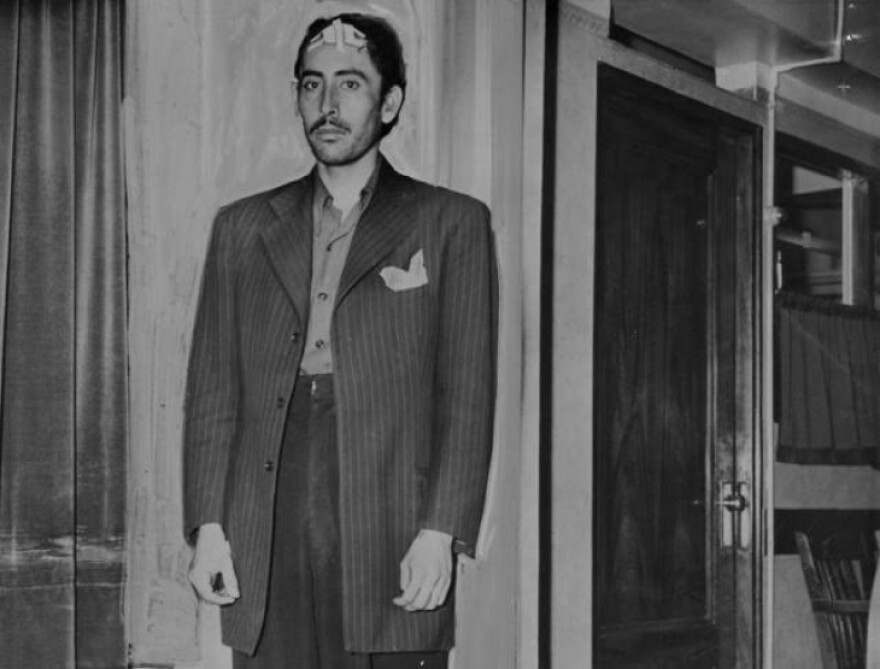Truth matters. Community matters. Your support makes both possible. LAist is one of the few places where news remains independent and free from political and corporate influence. Stand up for truth and for LAist. Make your year-end tax-deductible gift now.
It's Been 80 Years Since The Zoot Suit Riots. Understanding The Fashion Statement That Sparked A Racist Mob

Update June 2, 2023
This month marks the 80th anniversary of the outbreak of violent attacks in L.A. that targeted non-white men wearing a style of clothing known as a zoot suit.
Ahead of that anniversary, the L.A. County Board of Supervisors unanimously passed a motion last month calling the 1943 events "one of Los Angeles’ most shameful moments in history." The motion also said the county would "recommit to fighting against racial discrimination."
We looked back at the ugly history of that time in a photo history first published in 2019.
The zoot suit riots are considered to be "the first time in American history that fashion was believed to be the cause of widespread civil unrest," writes historian Kathy Peiss in Zoot Suit: The Enigmatic Career of an Extreme Style.
But the word "riot" is actually misleading, said Shmuel Gonzales, a blogger and local historian. It was actually more of an assault by groups of white U.S. soldiers and sailors, who were awaiting deployment during World War II. On June 3, 1943, the men charged through the city to harm young Mexican American men for wearing baggy (but stylish) suits. African American and Filipino men on the streets were also attacked.
The violence was the result of widespread panic among white Angelenos, who felt that "ethnic minorities were taking their claim on the town, and encouraging mixed race dancing during the age of segregation," Gonzales said. To summarize: White people rioted because of mixed race dancing.
Reports from the time explain that white residents saw men in zoot suits as "menacing street thugs, gang members and rebellious juvenile delinquents." And the L.A. Times fanned the flames. On June 2, 1943, the Times reported: "Fresh in the memory of Los Angeles is last year's surge of gang violence that made the 'zoot suit' a badge of delinquency. Public indignation seethed as warfare among organized bands of marauders, prowling the streets at night, brought a wave of assaults, [and] finally murders."

The June attacks were carried out with clubs and other crude weapons. And the resulting wave of racism inspired other mobs of servicemen to take to the streets, often stripping Latino men of their clothes and beating them until they were bloody and unconscious. Local police officers watched the beatings, then arrested the victims.
More servicemen, off-duty police officers and civilians joined in the mob mentality over the next several days, marching into cafes and movie theaters, beating up anyone wearing zoot-suit clothing or hairstyles.
No one was killed during the riots but hundreds of people were injured ... and the event sparked other zoot suit-related racial violence in other American cities like Philadelphia, Chicago and Detroit.
Next month marks the 80th anniversary of L.A.'s "riot." But to find the origins of zoot suit fashion, you have to go back to Harlem in the 1930s.
Zoot suits originated out of drape suits, which became popular in Black communities in 1930s New York. The style quickly spread throughout the U.S. and became fashionable among performers like Cab Calloway. In L.A., a pachuco or pachuca became a common phrase for Mexican American men and women who wore zoot suits.
Despite strict rationing of wool and other textiles during WWII, many bootleg tailors in Los Angeles (and New York) continued to make the suits with high-end fabrics.
Today, many Angelenos still embrace the style by wearing its trademark threads — baggy trousers and long jackets with padded shoulders — especially in majority Latino neighborhoods like Boyle Heights. "It's still a style that resonates," Gonzales said. "People identify with it."
But zoot suits were about more than just fashion. The style was a political statement for some men in L.A. and became a symbol for the racial tension in the city.
In honor of that history, please join us for a visual tour of the aftermath of the zoot suit fashion and the riots that followed, courtesy of the L.A. Public Library's (amazing) photo archive.
The only newspapers that decried the attacks at the time (during the age of Jim Crow) was the L.A. Reporter and Eastside Journal published by Al Waxman (the uncle of former Congressman Henry Waxman).
Editor's note
These photos include the the original captions from the Herald Examiner. The language used was heavily biased and tell a different story of the "riot" events. Shmuel Gonzales told us that's because the Herald Examiner was "notorious as one of biased newspapers, repeatedly skewing the news and causing hysteria about working-class people of color and their children."




















